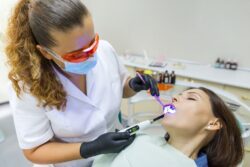If you feel nervous about going to the dentist, you are not alone. Modern dentistry prioritizes patient comfort and therefore made advancements in dental sedation, a form of medicine that induces a calm feeling during dental procedures. Patients with severe dental anxiety can benefit from this treatment option.
Sedation dentistry differs from anesthetics, a type of medication that prevents pain during dental work. But a dentist can employ both of these treatments in your dental procedure if needed. Read on to learn about the types of sedation and anesthesia a dentist can offer and how they differ from one another.

Local Anesthetics
A common reason people feel dental fear is the anticipation of pain during dental work. For many dental procedures, a dentist will take preventative measures to stop you from feeling discomfort in their chair. One way they do this is by giving you a local anesthetic.
This refers to an injection that a dentist will administer directly into a nerve near the affected part of the mouth. The medicine numbs the area for a brief period, ensuring the nerve does not transmit pain signals to the brain throughout the duration of your procedure. For additional comfort, a dentist can apply a topical anesthetic that will reduce pain from the local injection as well.
The numbness in this part of the mouth will last for a few hours, meaning you will notice it when you return home from your appointment. But this medicine does not interfere with your consciousness, so you can still operate machinery safely. You will not need to interrupt your daily schedule after this treatment.
Sedation Dentistry Options
Dental sedation refers to a type of medicine designed to create a feeling of calmness within a patient during their dental work. This differs from anesthetics, which target pain, because sedation addresses pervasive feelings of anxiety.
The effects of sedation will depend on which type of treatment you choose. Nitrous oxide, also known as laughing gas, is breathed through a mask over the nose or mouth. You remain awake but will have reduced awareness through the procedure. But once you breathe normal oxygen again, the effects will cease.
A dentist can also give you an oral sedative, a tablet taken before you arrive at your dentist’s office. This will leave a patient awake but relaxed. They may feel groggy well after the appointment, so this patient will require a lift to and from the office.
The dentist can also provide IV sedation, a medicine administered intravenously. With this treatment, a patient will enter deep sleep, not remaining aware of their surroundings. Once the medicine stops, the patient will wake up. But they will likely feel drowsy for the rest of the day. Plan your schedule accordingly.
General Anesthesia
General anesthesia is similar to IV sedation in that both medicines affect the patient’s consciousness and are delivered through an IV in the vein. Dentists often reserve both treatments for more extreme cases, such as those with severe anxiety or more intensive dental procedures.
But general anesthesia is often used for oral surgeries rather than routine dental work, so you would see this from a specialist. Your dentist can let you know which sedation options will suit your needs when you schedule a dental consultation.
